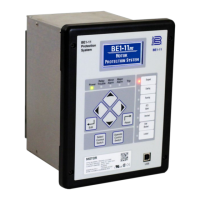42-2 9424200996
Fuse Loss (60FL) BE1-11m
Table 42-1. Fuse Loss Logic Parameters
Positive-sequence volts greater than 8.8% of the nominal voltage; Detects minimum voltage is applied.
Positive-sequence amps greater than 8.8% of the nominal current; Detects minimum current is applied.
Negative-sequence volts greater than 25% of the pos-seq volts; Detects loss of 1 or 2 phase voltages.
Negative-sequence amps less than 17.7% of the pos-seq amps; Detects a normal current condition.
Positive-sequence volts less than 8.8% of the nominal voltage; Detects loss of 3-phase voltage.
Positive-sequence amps less than 200% of the nominal current; Detects a normal load current condition.
Three-wire or four-wire sensing selected.
Positive-sequence volts greater than 85% of nominal voltage; Detects a restored voltage condition.
(B + S); Detects breaker position and nominal current condition.
(A * C * G * J * P); Detects when either one or two phases are lost.
(E * F * G * J); Detects when all three phases are lost.
Latches the 60FL output until the reset criteria are met.
(R+D); Logical OR of comparators R and D to detect a normal current condition.
Negative-sequence amps less than 15% of the nominal current; Detects a normal current condition.
S
Breaker Status is configured by the Breaker Status logic block. Information on setting up the breaker
status logic can be found in the Breaker Monitoring chapter. The Ignore Breaker Status setting is found
on the 60FL settings screen. (Enabled = 1, Disabled = 0)
Function Blocking
User selectable block settings determine how the 51/27R, 27, 59, 59X, 32, and 55 protection functions
operate when a fuse loss condition exists. The Block Voltage Control (51/27) setting assumes that the
voltage is V
NOM
when Fuse Loss is true because the voltage measurement is not present or is unreliable.
If the input voltage is nominal, then voltage restraint and control have no effect. The Block Voltage
settings determine which voltage functions are blocked when the Fuse Loss logic is true. The Block
Power/Power Factor setting blocks the power based functions when the Fuse Loss logic is true.
Protective elements blocked by 60FL should be set so that trip times
are 60 milliseconds or greater to assure proper coordination of
Programmable Alarm
The BE1-11m indicates an alarm condition when the 60FL element detects a fuse loss or loss of potential.
The alarm appears on the front-panel display, web page interface, and on the Alarms metering screen in
BESTCOMSPlus. Refer to the Alarms chapter for information on how to program alarms.
Logic Connections
Fuse loss logic connections are made on the BESTlogicPlus screen in BESTCOMSPlus. The fuse loss
element logic block is illustrated in Figure 42-2. The logic output is summarized in Table 42-2.
Figure 42-2. Fuse Loss Element Logic Block

